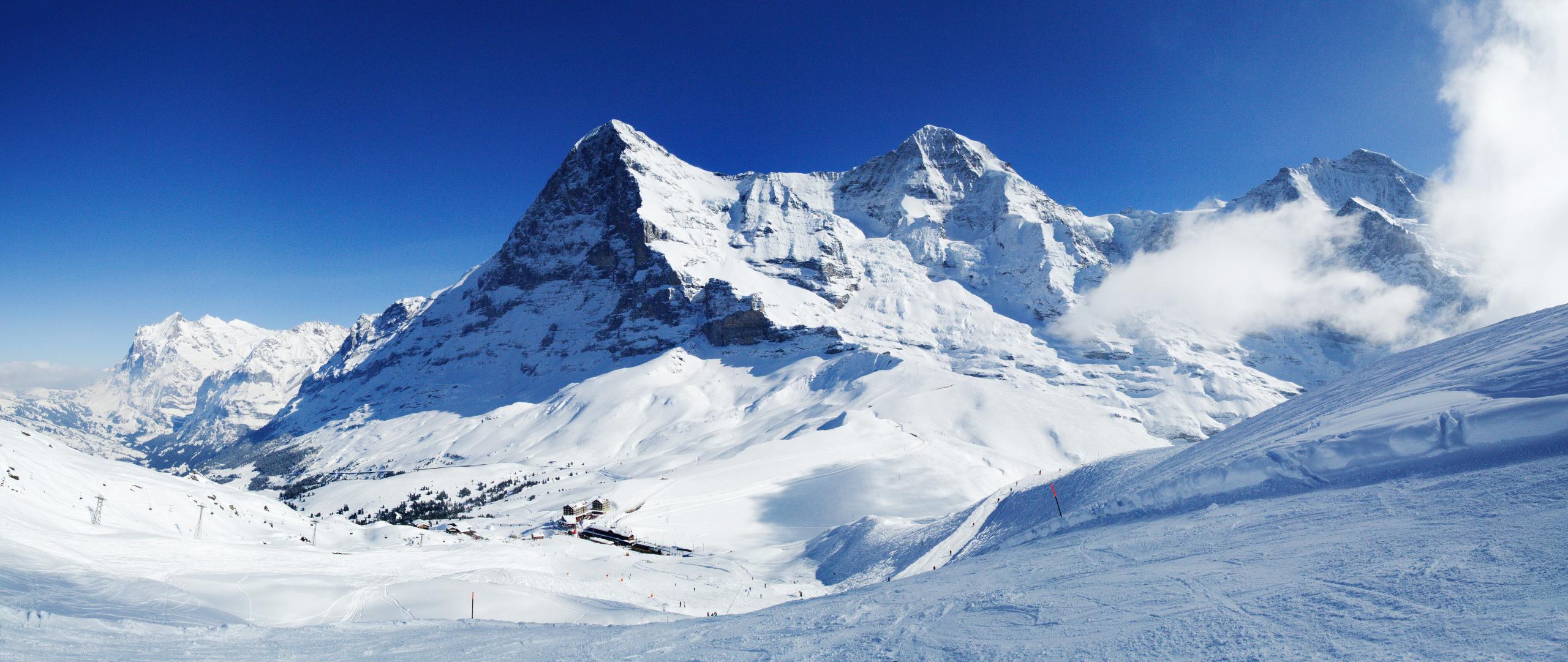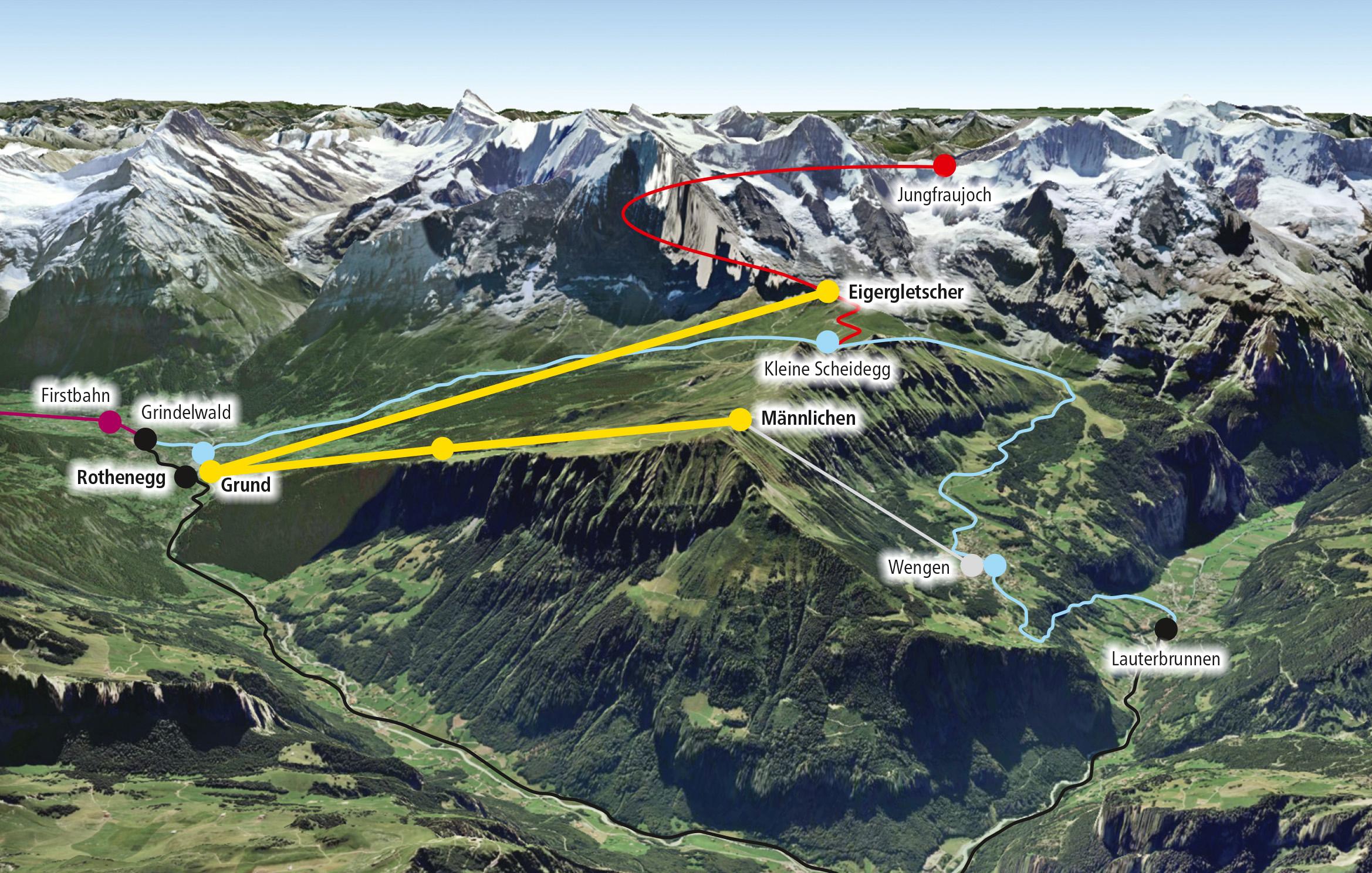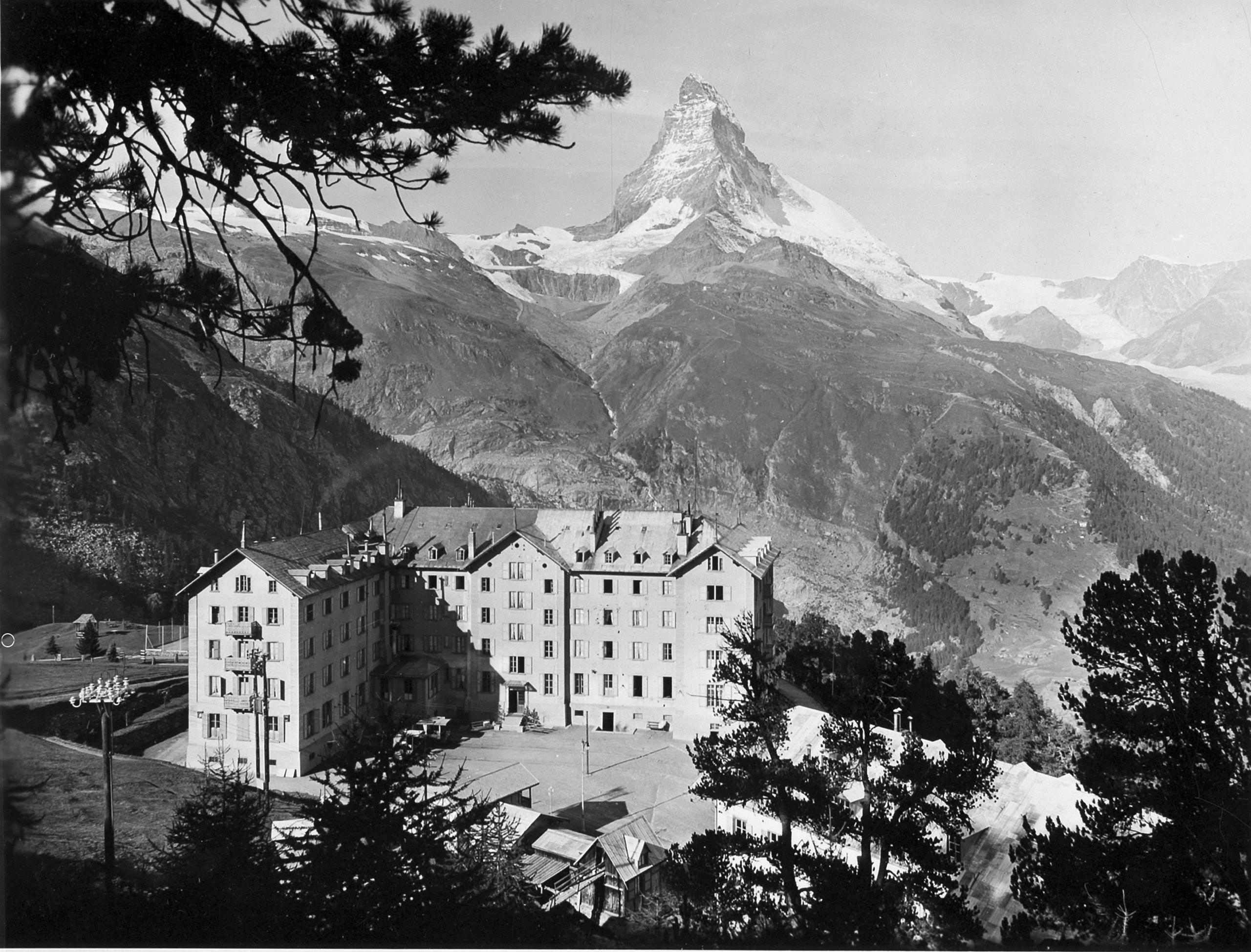Upgrade or bust: does mountain development benefit all?

Mountain railways are feeling the pressure to boost their business by taking more tourists to the top of Swiss peaks, and faster than they used to. But more tourists doesn’t mean the local economy benefits.
“Long queues” and “slow lifts” are the comments that come up time and again in online reviews of Grindelwald as a ski resort, right after compliments on the alpine scenery. During peak season, queues quickly form at the bottom of lifts and the railway as skiers and tourists with high expectations wait to reach the tops of the slopes.
But this could soon be changing if a new project to improve Grindelwald’s access to the ski slopes – and the popular “top of Europe” Jungfraujoch destination – goes ahead.
Tough choices
The people of Grindelwald, a well-developed mountain village in the Bernese Alps – promoted as the Jungfrau region, faced a conundrum recently over bringing better connections to the region’s peaks, bolstering the region’s coffers overall, but at the risk of encouraging mass tourism that will not necessarily boost local businesses.
They voted on whether to build a new gondola which will directly connect Grindelwald with Eigergletscher, a stop on the way to the Jungfraujoch.

The ‘V-Bahn’ project will shorten the total journey time from Grindelwald Grund station to Europe’s highest railway station at 3,454 metres, on the Jungfrau mountain, by 45 minutes. Plus, instead of the current 960 people per hour that the current line can carry, the new route will have the capacity for 2,720 people per hour.
Though more than two-thirds of residents gave the development the go-ahead, the project hit a snag – the mountain community in Grindelwald which holds the transit rights for the area over which the cable car will go, has so far not granted permission to Jungfrau Railways.
“I think we need it [the cable car] for the future, because the situation as it is now is not good anymore,” Emanuel Schläppi, mayor of Grindelwald, told swissinfo.ch.
He’s been party to lengthy discussions on all sides, but says he understands both points of view.
“We have very long queues in winter especially but also in the summer [for cable cars]…now we have the possibility to have a new system that is convenient for the people who come and want to be here in our valley.”
The project would also upgrade an old gondola route, the Männlichen cableway.
For those directly in the path of the new cable car, pylons obstructing their view of some of Switzerland’s most beautiful landscapes are far from welcome. But that’s not the only concern.
Public debate
The project generated a lot of discussion in the area. Local newspaper the Jungfrau Zeitung printed numerous readers’ letters on the topic. “Those who believe there are already enough railways and infrastructure in Grindelwald are wrong,” wrote Urs Hauser from Grindelwald. “It is precisely because the ski area facilities have not seen investment for so long that guests have drifted away to ski resorts with modern facilities.”
On the other side of the debate however, another Grindelwald resident questioned the project. “The chaos that will be created at the Eigergletscher station when the Eiger Express brings 2,400 people per hour and they then wait for a connection to the Jungfraujoch, has not been properly thought through,“ said Hansueli Schild from Grindelwald. “Is that quality tourism?”
Rainer Hercher, a regular visitor to the area felt passionate enough about the proposal to write a poem condemning the development. “We disfigure nature, without a trace of having once fully thought over what “gift” we are leaving our children.”
“People are afraid…they think big, huge crowds will come,” added Schläppi.
Overnight stays
That’s not to say that Grindelwald is a quaint village, untouched by tourism. The main stretch is lined with ski and souvenir shops, and a number of signs for important places such as bus terminals or chocolate retailers, are in both English and Japanese.
Around 823,000 visitors travelled on the Jungfrau railway to the Jungfraujoch station in 2013. According to the railway group’s own research, 70% of their customers come to the region primarily because of the Jungfraujoch, and the figure rises to 80% when only Asian tourists are taken into account.
The latest full year figures for the Jungfrau region (includes resorts of Grindelwald, Wengen, Mürren and Lauterbrunnen) show that over 385,000 people visited the area in 2013, spending an average of 2.5 nights.
Comparing these figures to those of the Jungfraujoch visitors, more than half of those who travelled up the famous mountain did not stay in the area.
Tourists on a whistle-stop tour of Europe that come and go in a day to experience what it’s like to stand on a glacier surrounded by glistening peaks are not the type of visitor that hotels and other local businesses back down at the base of the cable cars benefit much from.
Those from mainland China made up the second largest group of visitors to the region after the Swiss, but even they only stayed an average of just over one night each.
“The Chinese might be more on the move [than other tourists], staying overnight and then every day in a different location,” Christian Laesser, a professor at the Research Center for Tourism and Transport at the University of St Gallen, told swissinfo.ch.
The “classic extreme tour” generally involves around four countries with ten or 11 overnight stays, meaning just one or two nights would be spent in Switzerland, but not all nationalities or groups follow this pattern.
Although Laesser says the travel market is changing, he believes there will still be “top sites where everyone wants to go, they will not differ very much”.
Thinking fast and slow
Inside the village’s Japanese tourist information centre, a small office near the railway station with signs in Japanese out on the pavement, Yasuyo Ando who runs the bureau with her husband, thinks that with 16% of all overnight stays consistently taken up by the Japanese in Grindelwald, it is important to have something new that will keep attracting these visitors.
“A novelty, something eye-catching, and going faster to the Jungfraujoch…the impact will be good, but nonetheless in Grindelwald you can also enjoy calm, and quiet,” she told swissinfo.ch.
“It’s not just about going fast on the ski slopes or up to the glacier, Grindelwald is a very attractive, alpine-chic village, and it should be sold like that,” said Ando.
Mayor Schläppi believes the improved lift systems will also bring benefits to the village. “If we have queues that’s not good for people who stay in Grindelwald for a longer time. It’s not a question of more and more and more, it’s to be in the same market as all the other [tourist] destinations and have the same quality”.
Material perks
“A new cableway is a motor for a region,” Urs Kessler, CEO of Jungfrau Railways, told swissinfo.ch.
“This new project in Grindelwald will create a lot of awareness for the area, it will create new jobs, we estimate between 180-590, and [bring in] new business of around CHF30-60 million.”
The Railways will pay an annual amount to residents in the area over which the cable car will pass, for local amenities such as roads and huts for farmers. And they argue they have made a number of special multi-tickets and deals to keep people within the region for as long as possible, which will keep them in local hotels.
For Kessler, backing a project like the new cable car in Grindelwald is not just about that location, but about the whole Swiss package.
“It’s a project for the next 30 to 50 years. We are in very high competition with the countries surrounding us, within Europe. It’s an important project to keep the quality and competitiveness for the future.”
The cost of keeping up
Fighting off the competition is a key reason behind upgrading cable cars to Swiss peaks. In the Lucerne and Lake Lucerne region, improvements were made in November 2014 to the Titlis Railways, running from the valley village of Engelberg up to Mount Titlis. The well-known rotating cable car on this route was upgraded to a second generation model after 22 years, where no longer just the floor, but the whole cabin, rotates. It came in at a cost of around CHF2.5 million. In this region the average length of a stay was 1.8 nights in 2014, a little less than the figure ten years ago, and less than in the Bernese Oberland where visitors stayed two nights on average.
The industry group, Cable cars Switzerland say that 23% of all cable car stocks are publicly owned by the state. Two-thirds they say, would not survive in normal market conditions as they are given loans and benefits from the public purse.

In compliance with the JTI standards
More: SWI swissinfo.ch certified by the Journalism Trust Initiative











You can find an overview of ongoing debates with our journalists here . Please join us!
If you want to start a conversation about a topic raised in this article or want to report factual errors, email us at english@swissinfo.ch.